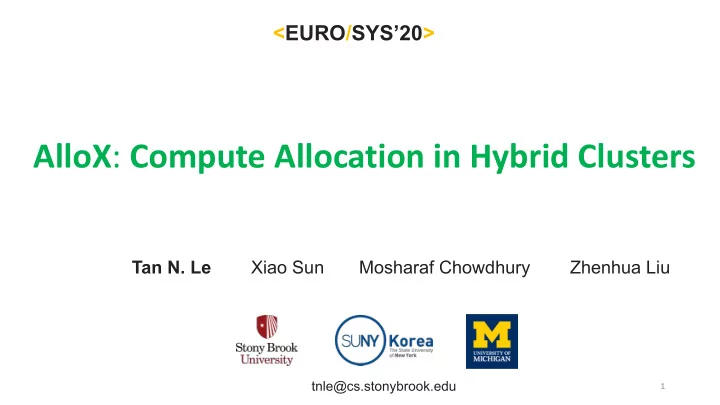

<EURO/SYS’20> AlloX : Compute Allocation in Hybrid Clusters Tan N. Le Xiao Sun Mosharaf Chowdhury Zhenhua Liu tnle@cs.stonybrook.edu 1
Resource Allocation in Clusters 99 % Fairness Performance Utilization 2
Resource Allocation Design Space Single Resource Multiple Resources Time Space Interchangeable Traditional CPU Sharing Memory Sharing DRF (nsdi’11), Carbyne (osdi’16) HUG (nsdi’16) Deadlines Performance & Fairness TetriSched AlloX (eurosys’16) 3
Interchangeability in Resources Same applications run on different resource types Tensorflow, Caffe, CNNLab, Tensorflow Pytorch, Matlab PaddlePaddle CPU GPU CPU GPU TPU FPGA GPU Modern Frameworks support Interchangeability https://github.com/PaddlePaddle/Paddle https://github.com/cnnlabs 4
Heterogeneity in hybrid CPU/GPU Clusters Traditional nodes Expensive GPUs Speed-up rates are distinct Intel E5 2.4Ghz CPU vs. Nvidia K80 GPU 5
Overload if most users prefer GPUs Expensive GPUs are overloaded while CPUs are under-utilized Microsoft Azure Let’s explore some solutions 6
Join the Shortest Queue (JSQ) GPU1 GPU2 Processing times JSQ CPU1 (GPU, CPU) CPU2 -69% makespan J1 (40, 50 ) GPU1 Optimal J2 (30, 40 ) -54% avg. compl. time GPU2 J3 ( 35 , 150) CPU1 J4 ( 50 , 160) CPU2 JSQ does not consider processing times 7
Shortest Job First (SJF) GPU1 GPU2 Processing times CPU1 (GPU, CPU) SJF CPU2 J1 (10, 20 ) -75% makespan J2 (15, 25 ) -60% avg. compl. time GPU1 J3 ( 20 , 100) Optimal GPU2 J4 ( 20 , 90) CPU1 CPU2 SJF does not consider speed-up rates 8
AlloX – Minimize Avg. Completion Time Convert the scheduling & placement J1 J?(G1) J? (G2) J? (G3) GPU Jobs J2 J? (C1) J?(C2) J? (C3) CPU J3 G1 into min-cost bipartite matching C1 J1 G2 J2 C2 J3 G3 C3 solved in polynomial time 9
AlloX – Maintains Fairness for interchangeable resources User A may not be happy if we keep putting him on CPU. Idea: Prioritize users with low fairness scores F who run jobs on the unfavorable resources F-1 < F-2 User 1 F-1 GPU User 2 F-2 CPU F-1 > F-2 10
Estimation Tool AlloX System Sample the jobs kubectl Jobs Estimate the processing times CPU configuration Processing times GPU configuration Scheduler Fairness : Pick the set of users with least fair scores Kubernetes Scheduling : Decide to place jobs on CPUs or GPUs. Placement constraints Configure a job to run on CPU or GPU Resource Placer kubelet GPUs CPUs 11
Performance of AlloX ×10 ! Avg. completion time (mins) 2968 3 DRF : Dominant Resource Fairness + FIFO Resource configurations are fixed 2 ES : Equal Share + SJF 1149 Keep filling the available resources 1 SRPT : Shortest Remaining Processing Time 139 97 Impractical switching between CPU&GPU ES AlloX SRPT DRF AlloX reduces up to 95% avg. completion time TensorFlow CNN benchmarks 12
<EURO/SYS’20> AlloX : Compute Allocation in Hybrid Clusters Tan N. Le Xiao Sun Mosharaf Chowdhury Zhenhua Liu tnle@cs.stonybrook.edu 13
Recommend
More recommend